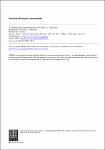Item Infomation
Full metadata record
| DC Field | Value | Language |
|---|---|---|
| dc.contributor.author | James E. Anderson | - |
| dc.date.accessioned | 2024-08-13T00:53:02Z | - |
| dc.date.available | 2024-08-13T00:53:02Z | - |
| dc.date.issued | 1979 | - |
| dc.identifier.uri | http://www.jstor.org/stable/1802501 . | - |
| dc.identifier.uri | http://thuvienso.thanglong.edu.vn//handle/TLU/10631 | - |
| dc.description.abstract | Probably the most successful empirical trade device of the last twenty-five years is the gravity equation. Applied to a wide variety of goods and factors moving over regional and national borders under dif fering circumstances, it usually produces a good fit. Unfortunately, as is widely recog nized, its use for policy is severely ham pered by its "unidentified" properties. Insertion into the equation of policy in struments such as border taxes has no theoretical justification; and inference about the effect of taxes from examining changes in the equation over times when taxes have changed carries no guarantee of validity | vi |
| dc.format.extent | pp. 106-116 | vi |
| dc.language.iso | en | vi |
| dc.publisher | American Economic Association | vi |
| dc.relation.ispartofseries | Vol. 69, No. 1 (Mar., 1979),; | - |
| dc.subject | Theoretical Foundation | vi |
| dc.subject | Gravity Equation | vi |
| dc.title | A Theoretical Foundation for the Gravity Equation | vi |
| dc.type | Bài báo/Newspaper | vi |
| Appears in Collections | Lĩnh vực Khoa học quản lý | |
Files in This Item:



